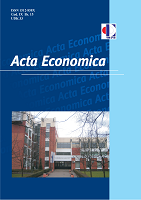РЕГИОНАЛИЗАЦИЈА СРБИЈЕ И ЕУ ФОНДОВИ
REGIONALIZATION OF SERBIA AND EU
Author(s): Gojko Rikalović, Dejan S. Molnar, Hristina MikićSubject(s): Economic policy, Economic development, EU-Approach / EU-Accession / EU-Development, Fiscal Politics / Budgeting
Published by: Економски факултет Универзитета у Бањој Луци
Keywords: regionalization; regional policy; NUTS; cohesion policy of EU; Serbia;
Summary/Abstract: The paper critically evaluates current regionalization and institutional framework for managing regional development policy in Serbia in the context of joining the European Union. Firstly, the current regionalization in Serbia is presented based on the standards of statistical nomenclature of Territorial Units for Statistics (NUTS) and EUROSTAT methodology. Then the institutional mechanism for guiding EU cohesion policy in the current budgetary period (2014-2020) is analyzed, as well as the availability and the purpose of EU funds for mitigation of regional disparities in the Member States. The paper points out that from the standpoint of the development needs of the NUTS 2 level in Serbia it might be better to define larger areas for the territorial units NUTS 3 level (administrative districts) instead of the current solutions (counties). The arguments that there is currently no adequate attention of the creators of economic and overall policy regarding the problems of regional development in Serbia are summed up. For more successful integration into the EU, Serbia has to conduct priority activities related to the establishment of an efficient institutional framework composed of various policy instruments, which should provide stability and continuity in regional development. However, a number of current issues are still opened (respect for the territorial aspect in setting development goals, the regional typology according to development criteria, interregional and intraregional relations, overcoming the problem of regional disparities in development). In this sense, the marginalization of these areas in public policy in Serbia is certainly not conducive to significant use of EU funds. In this context, in the coming period in Serbia it is necessary to implement the following processes: (a) completion of a comprehensive and coherent institutional framework for the management of regional policy, (b) the establishment of mechanisms for effective management of regional policy, especially to stimulate faster development of areas with specific development problems (c) the efficient use of EU funds and (d) the gradual functional and fiscal decentralization, in order to strengthen the capacity of local government to carry out activities aimed at local economic development. This is especially important if one takes into account the fact that all our regions belong to the first group of EU regions (less developed), because they are below the 75% of development compared to the EU average (the most developed region in Serbia – Belgrade region – has reached development level of about 60% of the EU average). Since 2012 Serbia has not had any strategic document in the field of regional development. This indicates that new strategic directions of development in terms of regional dimensions and in the context of the current economic and social developments are not defined. In this context, it is indicative that even in Eurostat Regional Yearbook, which records statistics for the European regions, Serbian regions are not even recognized, because EU finds have not reached agreement on statistical regions with Serbia. Bearing all this in mind, it can be concluded that Serbia is late with preparations in the field of regional policy and coordination of structural instruments. The concluding section contains the recommendations for the regional policy in Serbia in the future (the improvement of inter-municipal cooperation, the implementation of an integrated endogenous approach to development, improvement of regional statistics, better coordination of the work of the national line ministries, strengthening the capacity of local governments, etc.).
Journal: Acta Economica
- Issue Year: 15/2017
- Issue No: 26
- Page Range: 199-220
- Page Count: 22
- Language: Serbian

